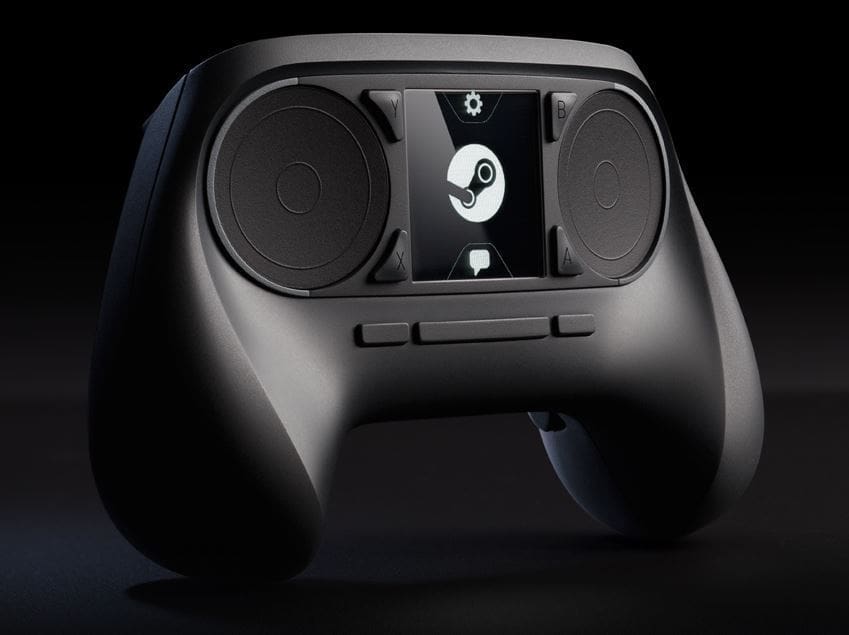
Half-Life 3 NOT confirmed!
Well, we were able to dream right? Two days ago we (and everyone else) predicted that despite all our hopes and dreams, that the final Valve Living Room announcement would be a controller for their newly announced Steam Machine; we were right.
We set out with a singular goal: bring the Steam experience, in its entirety, into the living-room. We knew how to build the user interface, we knew how to build a machine, and even an operating system. But that still left input — our biggest missing link. We realized early on that our goals required a new kind of input technology — one that could bridge the gap from the desk to the living room without compromises. So we spent a year experimenting with new approaches to input and we now believe we’ve arrived at something worth sharing and testing with you.
The idea of Valve making a controller should come as no surprise to anyone, as the purpose of their Steam Machine is to make a hybrid PC/Gaming Console for your living room; something with the accessibility of a console, but with the features of a PC. A specialized device made to control the Machine makes sense when you look at it that way.
The Steam Controller, which really needs a more personal name like “The Steamer” (Oh hell no!), at first glance bares a striking similarity to what I imagine would happen if an Xbox 360 controller mated with a DualShock 3, but that first glance is where the similarities end:

Quite a striking, albeit plain design, huh? Well, don’t worry on that, as this is still the prototype design, which means it will likely be polished up a little bit before final production. Speaking of prototyping, if you signed up yesterday to beta test the Steam Machine, you’re now also signed up to test the Steam Controller, so awesome on that!
Now onto the touted features taken from Valve:
Dual trackpads
The most prominent elements of the Steam controller are its two circular trackpads. Driven by the player’s thumbs, each one has a high-resolution trackpad as its base. It is also clickable, allowing the entire surface to act as a button. The trackpads allow far higher fidelity input than has previously been possible with traditional handheld controllers. Steam gamers, who are used to the input associated with PCs, will appreciate that the Steam Controller’s resolution approaches that of a desktop mouse.
Whole genres of games that were previously only playable with a keyboard and mouse are now accessible from the sofa. RTS games. Casual, cursor-driven games. Strategy games. 4x space exploration games. A huge variety of indie games. Simulation titles. And of course, Euro Truck Simulator 2.
In addition, games like first-person shooters that are designed around precise aiming within a large visual field now benefit from the trackpads’ high resolution and absolute position control.
This is the big selling point of the controller, in that they claim it can function as well as a keyboard & mouse, but with the relative ease of holding a controller. The design of the circular trackpads certainly is interesting, but I can’t help but be frustrated by them being on the same plane, instead of having an off-set design. Perhaps the slightly indented pad design will feel better with this design compared to non off-set thumbsticks.
Haptics
Trackpads, by their nature, are less physical than thumbsticks. By themselves, they are “light touch” devices and don’t offer the kind of visceral feedback that players get from pushing joysticks around. As we investigated trackpad-based input devices, it became clear through testing that we had to find ways to add more physicality to the experience. It also became clear that “rumble”, as it has been traditionally implemented (a lopsided weight spun around a single axis), was not going to be enough. Not even close.
The Steam Controller is built around a new generation of super-precise haptic feedback, employing dual linear resonant actuators. These small, strong, weighted electro-magnets are attached to each of the dual trackpads. They are capable of delivering a wide range of force and vibration, allowing precise control over frequency, amplitude, and direction of movement.
This haptic capability provides a vital channel of information to the player – delivering in-game information about speed, boundaries, thresholds, textures, action confirmations, or any other events about which game designers want players to be aware. It is a higher-bandwidth haptic information channel than exists in any other consumer product that we know of. As a parlour trick they can even play audio waveforms and function as speakers.
Controller vibrations have come a long way since the Nintendo 64 Rumble Pak, which existed in a time before we realized that a vibrated controller could make or break a game. The concept of the controller’s vibration sounds interesting, but after getting my hands on the Playstation 4’s upgraded DualShock, and the Xbox One’s immensely upgraded haptic feedback enabled controllers, it’s hard to believe that anything will be able to come out on top.
Touch Screen
In the center of the controller is another touch-enabled surface, this one backed by a high-resolution screen. This surface, too, is critical to achieving the controller’s primary goal – supporting all games in the Steam catalog. The screen allows an infinite number of discrete actions to be made available to the player, without requiring an infinite number of physical buttons.
The whole screen itself is also clickable, like a large single button. So actions are not invoked by a simple touch, they instead require a click. This allows a player to touch the screen, browse available actions, and only then commit to the one they want. Players can swipe through pages of actions in games where that’s appropriate. When programmed by game developers using our API, the touch screen can work as a scrolling menu, a radial dial, provide secondary info like a map or use other custom input modes we haven’t thought of yet.
In order to avoid forcing players to divide their attention between screens, a critical feature of the Steam Controller comes from its deep integration with Steam. When a player touches the controller screen, its display is overlayed on top of the game they’re playing, allowing the player to leave their attention squarely on the action, where it belongs.
Touch screens are all the rage in controllers these days, as they enable users more options when gaming. With the Steam Controller being made as a keyboard & mouse replacement, it makes the most sense to offer touch screen support, as it will allow users something more akin to the freedom they’re used to in most PC games.
Buttons
Every button and input zone has been placed based on frequency of use, precision required and ergonomic comfort. There are a total of sixteen buttons on the Steam Controller. Half of them are accessible to the player without requiring thumbs to be lifted from the trackpads, including two on the back. All controls and buttons have been placed symmetrically, making left or right handedness switchable via a software config checkbox.
Now, this is something that I cannot help but question: What the hell is up with the ‘face’ buttons? I understand Valve is basing their design over frequency of use and ergonomics, but as a longtime console gamer I find it odd to have the face buttons split up between both thumbs. Maybe in use it will feel fine, but I can imagine the current design is going to seriously trip up people used to one specific, or similarly specific, look/feel for controllers.
Sixteen buttons though, wow…that’s quite a few.
Shared configurations
In order to support the full catalog of existing Steam games (none of which were built with the Steam Controller in mind), we have built in a legacy mode that allows the controller to present itself as a keyboard and mouse. The Steam Community can use the configuration tool to create and share bindings for their favorite games. Players can choose from a list of the most popular configurations.
Openness
The Steam Controller was designed from the ground up to be hackable. Just as the Steam Community and Workshop contributors currently deliver tremendous value via additions to software products on Steam, we believe that they will meaningfully contribute to the design of the Steam Controller. We plan to make tools available that will enable users to participate in all aspects of the experience, from industrial design to electrical engineering. We can’t wait to see what you come up with.
One thing we can always say about Valve is that they’re open to customer opinions and thoughts. They’re also the most in touch with what PC gamers want out of their preferred platform. Giving customers the opportunity to hack and work with the controller is smart from a design perspective, as well a marketing perspective. It gives PC gamers yet another component to mess around with, finding out what works for them. I’m definitely curious to see what the community will come up with post launch.
If you’re looking to find out how to participate in the Steam Controller beta, or want to read up more on the controller or anything else related to Valve’s Living Room initiative, make sure to click here.
[SlideDeck2 id=9271]
"A man of many talents; Joshua is a gamer, writer, Sith Lord in training and a wannabe Time Lord. Assuming the mantle of Director of Gaming for Geek News Network, Joshua has made it his goal to bring the gaming division of GNN forward.
Will he succeed? Well, only by keeping up to date with the GNN gaming division will you be able to find out.
You can read more of Joshua’s semi-regular thoughts on Twitter @BearPunch. He also co-hosts the GNN Gaming Podcast and the ”Constantly Calibrating Podcast.
Joshua can be contacted at Joshua.Silverman@geeknewsnetwork.net for more information on GNN Gaming.”




























